FENTANYL LOZENGE - BUCCAL
PHONETIC PRONUNCIATION: (FEN-ta-nil)
COMMON BRAND NAME(S): Actiq
GENERIC NAME(S): fentanyl citrate
Uses
USES: This medication is used to help relieve sudden (breakthrough) cancer pain in people who are regularly taking moderate to large amounts of opioid pain medication. Fentanyl belongs to a class of drugs known as opioid (narcotic) analgesics. It works in the brain to change how your body feels and responds to pain. This medication should not be used to relieve mild or short-term pain (such as due to headache/migraine, dental procedures, surgery).
How to use FENTANYL LOZENGE - BUCCAL
HOW TO USE: Read the Medication Guide provided by your pharmacist before you start using fentanyl and each time you get a refill. Learn all usage and disposal instructions. If you have any questions, ask your doctor or pharmacist. A Child Safety Kit is available from the manufacturer. It contains important safety and educational materials and a safe storage container to keep this medication out of reach of children. If you have any questions about the materials in this kit, bring them to your doctor or pharmacist, or contact the manufacturer. Use fentanyl lozenges as directed by your doctor. Just before using, open the package with scissors. Remove the lozenge and place the medication end in your mouth between your cheeks and gums. Actively suck on the medication. Twirl the handle often and move the medication along the cheeks in your mouth, occasionally switching sides of the mouth. You should finish the medication in 15 minutes to get the most relief. Do not bite or chew the medication. You may drink some water before using this medication, but do not eat or drink anything while you are using it. Avoid eating grapefruit or drinking grapefruit juice while using this medication unless your doctor or pharmacist says you may do so safely. Grapefruit can increase the chance of side effects with this medicine. Ask your doctor or pharmacist for more details. If you start to have side effects (such as dizziness, feeling sick to your stomach, severe drowsiness) before finishing a dose, your doctor may need to adjust your dose. Remove the rest of the lozenge from your mouth and store or dispose of it properly (see Medication Guide). Tell your doctor promptly if this happens. The dosage is based on your medical condition and response to treatment. If you need a second dose, wait 30 minutes after starting the first dose. Do not use more than 2 doses per episode of breakthrough pain. Wait at least 4 hours before using fentanyl lozenges again for another episode of breakthrough pain. To avoid any confusion and chance of overdose, you should only keep a supply of one strength of this medication. Do not increase your dose, take the medication more frequently, or take it for a longer time than prescribed. Pain medications work best if they are used when the first signs of pain occur. If you wait until the pain has worsened, the medication may not work as well. You should continue to also take your long-acting opioid medication as directed by your doctor. Other pain relievers (such as acetaminophen, ibuprofen) may also be prescribed. Ask your doctor or pharmacist about using fentanyl safely with other drugs. This medication may cause withdrawal reactions, especially if it has been used regularly for a long time or in high doses. In such cases, withdrawal symptoms (such as restlessness, watering eyes, runny nose, nausea, sweating, muscle aches) may occur if you suddenly stop using this medication. To prevent withdrawal reactions, your doctor may reduce your dose gradually. Ask your doctor or pharmacist for more details, and report any withdrawal reactions right away. When this medication is used for a long time, it may not work as well. Talk with your doctor if this medication stops working well. Though it helps many people, this medication may sometimes cause addiction. This risk may be higher if you have a substance use disorder (such as overuse of or addiction to drugs/alcohol). Use this medication exactly as prescribed to lower the risk of addiction. Ask your doctor or pharmacist for more details. Tell your doctor if your pain persists or worsens, if you have more than 4 episodes of breakthrough pain daily, or if you need to use 2 units of medication for each episode of pain.
Side Effects
Precautions
Interactions
Overdose
Images
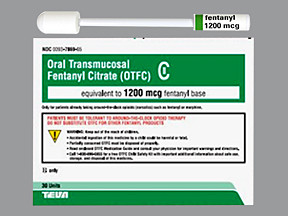
- color
- white
- shape
- other
- imprint
- fentanyl 1200 mcg
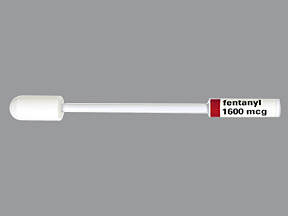
- color
- white
- shape
- other
- imprint
- fentanyl 1600 mcg
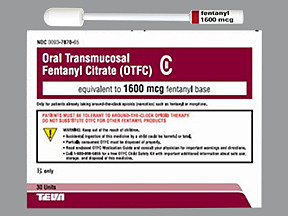
- color
- white
- shape
- other
- imprint
- fentanyl 1600 mcg
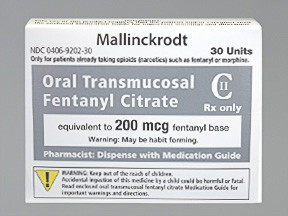
- color
- white
- shape
- other
- imprint
- FENTANYL 200 MCG, 1
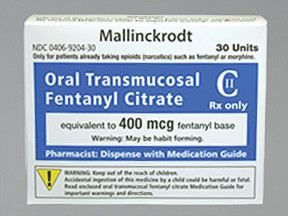
- color
- white
- shape
- other
- imprint
- FENTANYL 400 MCG
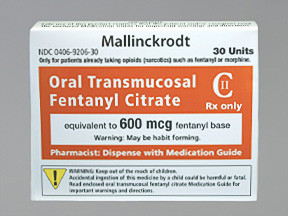
- color
- white
- shape
- other
- imprint
- FENTANYL 600 MCG
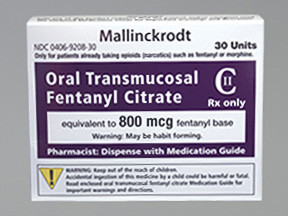
- color
- white
- shape
- other
- imprint
- FENTANYL 800 MCG
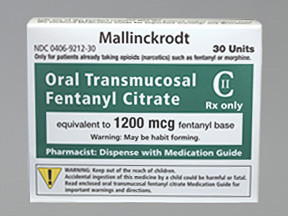
- color
- white
- shape
- other
- imprint
- FENTANYL 1200 MCG
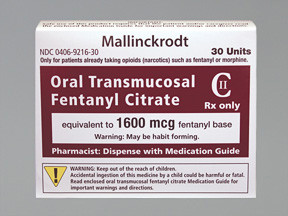
- color
- white
- shape
- other
- imprint
- FENTANYL 1600 MCG
Reviews
Warning
WARNING: See also Uses section. Fentanyl has a risk for abuse and addiction, which can lead to overdose and death. Fentanyl may also cause severe, possibly fatal, breathing problems. Do not use fentanyl lozenges unless you have been regularly taking moderate to large amounts of opioid pain medication. Otherwise, it may cause overdose (even death). To lower your risk, your doctor should have you use the smallest dose of fentanyl that works, and use it for the shortest possible time. See also How to Use section for more information about addiction. The risk for severe breathing problems is higher when you start this medication and after a dose increase, or if you use the wrong dose/strength. Using this medication with alcohol or other drugs that can cause drowsiness or breathing problems may cause very serious side effects, including death. Be sure you know how to use fentanyl and what other drugs you should avoid using with it. See also Drug Interactions section. Get medical help right away if any of these very serious side effects occur: slow/shallow breathing, unusual lightheadedness, severe drowsiness/dizziness, difficulty waking up. Carefully follow the specific directions for using fentanyl lozenges. Since they are not taken the same way, different forms of fentanyl (including lozenges, buccal tablets, patches) do not have the same effects at equal strengths and should not be substituted for each other. Tell your doctor or pharmacist of all medications that you use, especially of drugs that can affect how fentanyl works. Do not start, stop, or change the dosage of any medicines you are using without your doctor's approval. Keep this medicine in a safe place to prevent theft, misuse, or abuse. Properly throw away all opened units of this drug. If someone accidentally swallows this drug, get medical help right away. Because of the risk of misuse, abuse, and overdose, you will need to register with a special distribution program before receiving your prescription. Only doctors and pharmacies enrolled in this program may prescribe or dispense this medication. Ask your doctor or pharmacist for details. Before using this medication, women of childbearing age should talk with their doctor(s) about the risks and benefits. Tell your doctor if you are pregnant or if you plan to become pregnant. During pregnancy, this medication should be used only when clearly needed. It may slightly increase the risk of birth defects if used during the first two months of pregnancy. Also, using it for a long time or in high doses near the expected delivery date may harm the unborn baby. To lessen the risk, use the smallest effective dose for the shortest possible time. Babies born to mothers who use this drug for a long time may develop severe (possibly fatal) withdrawal symptoms. Tell the doctor right away if you notice any symptoms in your newborn baby such as crying that doesn't stop, slow/shallow breathing, irritability, shaking, vomiting, diarrhea, poor feeding, or difficulty gaining weight.
Disclaimer
IMPORTANT: HOW TO USE THIS INFORMATION: This is a summary and does NOT have all possible information about this product. This information does not assure that this product is safe, effective, or appropriate for you. This information is not individual medical advice and does not substitute for the advice of your health care professional. Always ask your health care professional for complete information about this product and your specific health needs.
No Reviews Yet